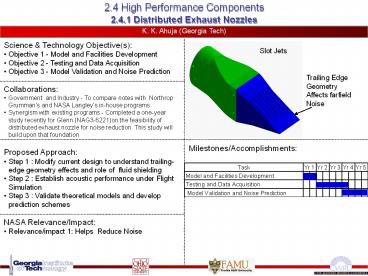2.4.1 Distributed Exhaust Nozzles - PowerPoint PPT Presentation
1 / 2
Title:
2.4.1 Distributed Exhaust Nozzles
Description:
Government and Industry - To compare notes with Northrop Grumman's and NASA ... Design and fabricate a distributed nozzle with different wedge geometries to ... – PowerPoint PPT presentation
Number of Views:51
Avg rating:3.0/5.0
Title: 2.4.1 Distributed Exhaust Nozzles
1
2.4.1 Distributed Exhaust Nozzles
2.4 High Performance Components
K. K. Ahuja (Georgia Tech)
- Science Technology Objective(s)
- Objective 1 - Model and Facilities Development
- Objective 2 - Testing and Data Acquisition
- Objective 3 - Model Validation and Noise
Prediction
- Collaborations
- Government and Industry - To compare notes with
Northrop Grummans and NASA Langleys in-house
programs - Synergism with existing programs - Completed a
one-year study recently for Glenn (NAG3-6221)on
the feasibility of distributed exhaust nozzle for
noise reduction. This study will build upon that
foundation
- Milestones/Accomplishments
- Proposed Approach
- Step 1 Modify current design to understand
trailing-edge geometry effects and role of fluid
shielding - Step 2 Establish acoustic performance under
Flight Simulation - Step 3 Validate theoretical models and develop
prediction schemes
- NASA Relevance/Impact
- Relevance/impact 1 Helps Reduce Noise
2
2.4.1 Proposed Approach
- The basis of this approach is that large number
of small jets, characteristic of a distributed
exhaust produce noise at frequencies outside the
human hearing range. Also, if spaced suitably,
the jets coalesce at smaller velocities, thus
producing low-amplitude noise at low frequencies. - Design and fabricate a distributed nozzle with
different wedge geometries to understand the role
of the trailing edge of the nozzle. - Mount the nozzle in an anechoic flight
simulation facility and test its effectiveness
in reducing noise as a function of jet exit
velocity and flight speed. - Measure the effect of flight on the fluid
shielding of noise provided by individual slot
jets. - Measurements to include farfield acoustic
signatures, flow visualization, and PIV data. - Correlate the data where possible with
theoretical models and develop a noise prediction
scheme































